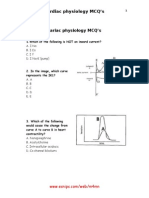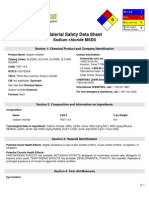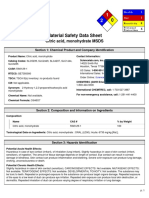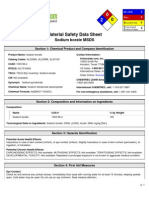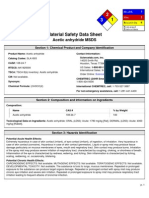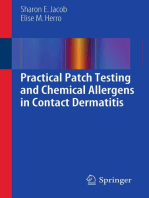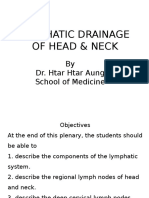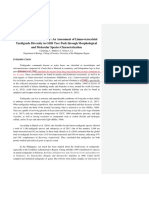14.kalium Dikromat
14.kalium Dikromat
Uploaded by
Darla PowersCopyright:
Available Formats
14.kalium Dikromat
14.kalium Dikromat
Uploaded by
Darla PowersOriginal Description:
Original Title
Copyright
Available Formats
Share this document
Did you find this document useful?
Is this content inappropriate?
Copyright:
Available Formats
14.kalium Dikromat
14.kalium Dikromat
Uploaded by
Darla PowersCopyright:
Available Formats
0 4
Material Safety Data Sheet
Potassium dichromate MSDS
Section 1: Chemical Product and Company Identification
Product Name: Potassium dichromate Catalog Codes: SLP5455, SLP2629 CAS#: 7778-50-9 RTECS: HX7680000 TSCA: TSCA 8(b) inventory: Potassium dichromate CI#: Not available. Synonym: Bichromate of potash; Dipotassium Dichromate; Potassium bichromate; Potassium dichromate (VI) Chemical Name: Not available. Chemical Formula: K2Cr2O7 Contact Information: Sciencelab.com, Inc. 14025 Smith Rd. Houston, Texas 77396 US Sales: 1-800-901-7247 International Sales: 1-281-441-4400 Order Online: ScienceLab.com
He a lt h
4 0 0 E
Fire Re a c t iv it y P e rs o n a l P ro t e c t io n
CHEMTREC (24HR Emergency Telephone), call: 1-800-424-9300 International CHEMTREC, call: 1-703-527-3887 For non-emergency assistance, call: 1-281-441-4400
Section 2: Composition and Information on Ingredients
Composition: Name Potassium dichromate CAS # 7778-50-9 % by Weight 100
Toxicological Data on Ingredients: Potassium dichromate LD50: Not available. LC50: Not available.
Section 3: Hazards Identification
Potential Acute Health Effects: Extremely hazardous in case of skin contact (permeator). Very hazardous in case of skin contact (irritant), of eye contact (irritant), of ingestion, . Hazardous in case of skin contact (corrosive, sensitizer), of eye contact (corrosive), of inhalation (lung irritant). Prolonged exposure may result in skin burns and ulcerations. Over-exposure by inhalation may cause respiratory irritation. Severe over-exposure can result in death. Inflammation of the eye is characterized by redness, watering, and itching. Skin inflammation is characterized by itching, scaling, reddening, or, occasionally, blistering. Potential Chronic Health Effects: Slightly hazardous in case of skin contact (sensitizer). CARCINOGENIC EFFECTS: Classified A1 (Confirmed for human.) by ACGIH. MUTAGENIC EFFECTS: Mutagenic for mammalian somatic cells. Mutagenic for bacteria and/or yeast. TERATOGENIC EFFECTS: Not available. DEVELOPMENTAL TOXICITY: Not available. The substance may be toxic to blood, kidneys, lungs, liver, upper respiratory tract, skin, eyes. Repeated or prolonged exposure to the substance can produce target organs damage. Repeated exposure to a highly toxic material may produce general deterioration of health by an accumulation in one or many human organs.
p. 1
Section 4: First Aid Measures
Eye Contact: Check for and remove any contact lenses. Immediately flush eyes with running water for at least 15 minutes, keeping eyelids open. Cold water may be used. Do not use an eye ointment. Seek medical attention. Skin Contact: After contact with skin, wash immediately with plenty of water. Gently and thoroughly wash the contaminated skin with running water and non-abrasive soap. Be particularly careful to clean folds, crevices, creases and groin. Cold water may be used. Cover the irritated skin with an emollient. If irritation persists, seek medical attention. Serious Skin Contact: Wash with a disinfectant soap and cover the contaminated skin with an anti-bacterial cream. Seek medical attention. Inhalation: Allow the victim to rest in a well ventilated area. Seek immediate medical attention. Serious Inhalation: Evacuate the victim to a safe area as soon as possible. Loosen tight clothing such as a collar, tie, belt or waistband. If breathing is difficult, administer oxygen. If the victim is not breathing, perform mouth-to-mouth resuscitation. Seek medical attention. Ingestion: Do not induce vomiting. Loosen tight clothing such as a collar, tie, belt or waistband. If the victim is not breathing, perform mouth-to-mouth resuscitation. Seek immediate medical attention. Serious Ingestion: Not available.
Section 5: Fire and Explosion Data
Flammability of the Product: Non-flammable. Auto-Ignition Temperature: Not applicable. Flash Points: Not applicable. Flammable Limits: Not applicable. Products of Combustion: Not available. Fire Hazards in Presence of Various Substances: combustible materials, organic materials Explosion Hazards in Presence of Various Substances: Risks of explosion of the product in presence of mechanical impact: Not available. Risks of explosion of the product in presence of static discharge: Not available. Fire Fighting Media and Instructions: Not applicable. Special Remarks on Fire Hazards: Dangerous in contact with organic materials. Contact with combustible or organic materials may cause fire. When heated to decomposition it emits toxic fumes of potassium oxide Special Remarks on Explosion Hazards: Reacts explosively with hydrazine, and anydrous hydroxylamine.
Section 6: Accidental Release Measures
Small Spill: Use appropriate tools to put the spilled solid in a convenient waste disposal container. Large Spill: Oxidizing material. Stop leak if without risk. Avoid contact with a combustible material (wood, paper, oil, clothing...). Keep substance damp using water spray. Do not touch spilled material. Prevent entry into sewers, basements or confined areas; dike if needed. Call for assistance on disposal. Be careful that the product is not present at a concentration level above TLV. Check TLV on the MSDS and with local authorities.
p. 2
Section 7: Handling and Storage
Precautions: Keep locked up Keep container dry. Keep away from heat. Keep away from sources of ignition. Keep away from combustible material Do not breathe dust. Never add water to this product In case of insufficient ventilation, wear suitable respiratory equipment If you feel unwell, seek medical attention and show the label when possible. Avoid contact with skin and eyes Keep away from incompatibles such as reducing agents, combustible materials, organic materials. Storage: Oxidizing materials should be stored in a separate safety storage cabinet or room.
Section 8: Exposure Controls/Personal Protection
Engineering Controls: Use process enclosures, local exhaust ventilation, or other engineering controls to keep airborne levels below recommended exposure limits. If user operations generate dust, fume or mist, use ventilation to keep exposure to airborne contaminants below the exposure limit. Personal Protection: Splash goggles. Lab coat. Dust respirator. Be sure to use an approved/certified respirator or equivalent. Gloves. Personal Protection in Case of a Large Spill: Splash goggles. Full suit. Dust respirator. Boots. Gloves. A self contained breathing apparatus should be used to avoid inhalation of the product. Suggested protective clothing might not be sufficient; consult a specialist BEFORE handling this product. Exposure Limits: CEIL: 0.1 (mg(CrO3)/m ) from OSHA (PEL) [United States] TWA: 0.05 (mg(Cr)/m) from ACGIH (TLV) [United States]Consult local authorities for acceptable exposure limits.
Section 9: Physical and Chemical Properties
Physical state and appearance: Solid. Odor: Odorless. Taste: Bitter. metallic. Molecular Weight: 294.2 g/mole Color: Orange-Red. pH (1% soln/water): 4 [Acidic.] Boiling Point: Decomposition temperature: 500C (932F) Melting Point: 398C (748.4F) Critical Temperature: Not available. Specific Gravity: 2.676 @ 25 deg. C(Water = 1) Bulk Density: 1.6 g/m3 @ 20 deg. C Vapor Pressure: Not applicable. Vapor Density: Not available. Volatility: Not available. Odor Threshold: Not available. Water/Oil Dist. Coeff.: Not available. Ionicity (in Water): Not available. p. 3
Dispersion Properties: See solubility in water. Solubility: Easily soluble in hot water. Soluble in cold water. Solubility in water: 4.9 g/100 ml water @ 0 deg. C Solubility in water: 10.5% (w/w) @ 20 deg. C Solubility in water: 102 g/100 ml water @ 100 deg. C Insoluble in alcohol.
Section 10: Stability and Reactivity Data
Stability: The product is stable. Instability Temperature: Not available. Conditions of Instability: Incompatible materials Incompatibility with various substances: Reactive with reducing agents, combustible materials, organic materials, metals, acids, alkalis. Corrosivity: Non-corrosive in presence of glass. Special Remarks on Reactivity: Reacts violently or ignites with ethylene glycol above 100 deg. C Other Incompatibles: combustible, organic, or other readily oxidizable materials such as paper, wood, sulfur, aluminum, iron, tungsten, sulfuric acid + acetone, born, glycol, sulfur, plastics Special Remarks on Corrosivity: Not available. Polymerization: No.
Section 11: Toxicological Information
Routes of Entry: Absorbed through skin. Dermal contact. Eye contact. Inhalation. Ingestion. Toxicity to Animals: Acute oral toxicity (LD50): 25 mg/kg [Rat]. Acute dermal toxicity (LD50): 14 mg/kg [Rabbit]. Chronic Effects on Humans: CARCINOGENIC EFFECTS: Classified A1 (Confirmed for human.) by ACGIH. MUTAGENIC EFFECTS: Mutagenic for mammalian somatic cells. Mutagenic for bacteria and/or yeast. May cause damage to the following organs: blood, kidneys, lungs, liver, upper respiratory tract, skin, eyes. Other Toxic Effects on Humans: Extremely hazardous in case of skin contact (permeator). Very hazardous in case of skin contact (irritant), of ingestion, . Hazardous in case of skin contact (corrosive, sensitizer), of eye contact (corrosive), of inhalation (lung irritant). Special Remarks on Toxicity to Animals: Lowest Published Lethal Dose: LDL [Man] - Route: Oral; Dose: 143 mg/kg LDL [Child] - Route: Oral; Dose 26 mg/kg Special Remarks on Chronic Effects on Humans: Passes through the placental barrier in animal. May cause adverse reproductive effects and birth defects (teratogenic). May affect genetic material (mutagenic) Special Remarks on other Toxic Effects on Humans: Acute Potential Health Effects: Skin: It causes skin irritation and may cause skin burns. It can be absorbed by the skin and cause systemic effects. Deep ulceration of the skin of the hands, resulting from occupational exposure can penetrate as far as the bone in severe cases. Eyes: Causes eye irritation and may cause eye burns. It may cause severe damage with possible loss of vision, transient corneal bulging, residual irregular astigmatism, and anesthesia of the area after bulging resolves. Inhalation: Causes respiratory tract irritation. Inhalation of dust or mist can also cause irritation of the nose and eyes. Symptoms may include sneezing, rhinorrhea, throat erythema, nasal septum lesions, or perforation with with bleeding, disharge, or crusting Ingestion: Harmful if swallowed. When ingested in small amounts, it can cause burns of the esophagus, with possible stricture formation and perforation of the stomach. Symptoms may include adbominal and esophageal pain, nausea, vomiting, hypermotility, diarrhea, gastrointestinal tract irritation and bleeding, respiratory distress, cyanosis, coma, and death. It may also affect the cardiovascular system (cardiovascular shock, peripheral vascular collapse, urinary system (kidney p. 4
damage - nephritis with glycosuria, acute tubular necrosis, renal failure), liver (elevated liver enzyme levels, hepatits, hepatic failure), behavior/central nervous system/nervous system (somnolence, ataxia, vertigo, muscle cramps). It may also affect the blood and cause anemia, methemglobinemia (characterized by dizziness, drowsiness, headache, shortness of breath, cyanosis with bluish skin, rapid heart
Section 12: Ecological Information
Ecotoxicity: Ecotoxicity in water (LC50): 75 mg/l 96 hours [Fish (Striped bass)]. 1.5 mg/l 24 hours [Daphnia (daphnia)]. 17.3 mg/l 11 hours [Fish (Fathead minnow)]. BOD5 and COD: Not available. Products of Biodegradation: Possibly hazardous short term degradation products are not likely. However, long term degradation products may arise. Toxicity of the Products of Biodegradation: The products of degradation are more toxic. Special Remarks on the Products of Biodegradation: Dangerous to aquatic life in high concentrations. Chromium probably occurs as the insoluble (CrIII) oxide (Cr2O3.nH2O) in the soil, as the organic matter in the soil is expected to reduce any soluble chromate to insoluble chromic oxide (Cr2O3). Chromium in the soil can be transported to the atmosphere by way of aerosol formation. Chromium is also transported from the soil through runoff and leaching of water. Most of the chromium in surface waters may be present in particulate from as sediment. Some of the particulate chromium would remain as suspended matter and ultimately be deposited in the sediments. Chromium present usually as (CrIII) in the soil and is characteriszed by its lack of mobility, except in cases where Cr(VI) is involved. Chromium (VI) of natural origin is rarely found.
Section 13: Disposal Considerations
Waste Disposal: Waste must be disposed of in accordance with federal, state and local environmental control regulations.
Section 14: Transport Information
DOT Classification: CLASS 5.1: Oxidizing material. CLASS 6.1: Poisonous material. Identification: : Toxic Solids, Oxidizing, n.o.s (Potassium Dichromate) UNNA: 3086 PG: I Special Provisions for Transport: Not available.
Section 15: Other Regulatory Information
Federal and State Regulations: California prop. 65: This product contains the following ingredients for which the State of California has found to cause cancer, birth defects or other reproductive harm, which would require a warning under the statute: Potassium dichromate California prop. 65: This product contains the following ingredients for which the State of California has found to cause cancer which would require a warning under the statute: Potassium dichromate Pennsylvania RTK: Potassium dichromate Massachusetts RTK: Potassium dichromate TSCA 8(b) inventory: Potassium dichromate SARA 313 toxic chemical notification and release reporting: Potassium dichromate CERCLA: Hazardous substances.: Potassium dichromate Other Regulations: OSHA: Hazardous by definition of Hazard Communication Standard (29 CFR 1910.1200). Other Classifications: WHMIS (Canada): p. 5
CLASS C: Oxidizing material. CLASS D-1A: Material causing immediate and serious toxic effects (VERY TOXIC). CLASS D-2A: Material causing other toxic effects (VERY TOXIC). DSCL (EEC): R21- Harmful in contact with skin. R25- Toxic if swallowed. R26- Very toxic by inhalation. R37/38- Irritating to respiratory system and skin. R41- Risk of serious damage to eyes. R43- May cause sensitization by skin contact. R46- May cause heritable genetic damage. R49- May cause cancer by inhalation. R50/53- Very toxic to aquatic organisms, may cause long-term adverse effects in the aquatic environment. S45- In case of accident or if you feel unwell, seek medical advice immediately (show the label where possible). S53- Avoid exposure - obtain special instructions before use. S60- This material and its container must be disposed of as hazardous waste. S61- Avoid release to the environment. Refer to special instructions/Safety data sheets. HMIS (U.S.A.): Health Hazard: 4 Fire Hazard: 0 Reactivity: 0 Personal Protection: E National Fire Protection Association (U.S.A.): Health: 4 Flammability: 0 Reactivity: 0 Specific hazard: Protective Equipment: Gloves. Lab coat. Dust respirator. Be sure to use an approved/certified respirator or equivalent. Wear appropriate respirator when ventilation is inadequate. Splash goggles.
Section 16: Other Information
References: Not available. Other Special Considerations: Not available. Created: 10/10/2005 08:49 PM Last Updated: 11/01/2010 12:00 PM The information above is believed to be accurate and represents the best information currently available to us. However, we make no warranty of merchantability or any other warranty, express or implied, with respect to such information, and we assume no liability resulting from its use. Users should make their own investigations to determine the suitability of the information for their particular purposes. In no event shall ScienceLab.com be liable for any claims, losses, or damages of any third party or for lost profits or any special, indirect, incidental, consequential or exemplary damages, howsoever arising, even if ScienceLab.com has been advised of the possibility of such damages.
p. 6
You might also like
- The Health & Safety Guide for Film, TV & Theater, Second EditionFrom EverandThe Health & Safety Guide for Film, TV & Theater, Second EditionRating: 4 out of 5 stars4/5 (1)
- Cardiac Physiology MCQsDocument13 pagesCardiac Physiology MCQsالعراقي الصامد100% (3)
- Come Thirsty Chapter1Document4 pagesCome Thirsty Chapter1Natalia Lupasco100% (1)
- The Alinity H-Series Staining GuideDocument14 pagesThe Alinity H-Series Staining GuideShahid HussainNo ratings yet
- Potassium Dichromate MSDS: Section 1: Chemical Product and Company IdentificationDocument6 pagesPotassium Dichromate MSDS: Section 1: Chemical Product and Company IdentificationRicky SetiawanNo ratings yet
- Msds NaclDocument6 pagesMsds NaclNur Oktri Mulya DewiNo ratings yet
- Master Tung Magic PointDocument11 pagesMaster Tung Magic Pointalvaedison00100% (4)
- Anatomy and Physiology NotesDocument4 pagesAnatomy and Physiology NotesTristan Arambulo100% (1)
- MsdsDocument6 pagesMsdsWind AzCaNo ratings yet
- Msds Kalium DikromatDocument6 pagesMsds Kalium DikromatKeynan HaqieNo ratings yet
- Sodium Chromate Anhydrous PDFDocument6 pagesSodium Chromate Anhydrous PDFErika WidiariniNo ratings yet
- MSDS of Sodium DichromateDocument6 pagesMSDS of Sodium DichromateJackiee1983No ratings yet
- KCLO3Document6 pagesKCLO3Raditya Rizki AmaliaNo ratings yet
- MSDSDocument6 pagesMSDSAra HilisNo ratings yet
- Material Safety Data SheetDocument6 pagesMaterial Safety Data Sheetonna25No ratings yet
- Ferric Chloride HexahydrateDocument6 pagesFerric Chloride HexahydrateDust HooNo ratings yet
- Msds ThioacetamideDocument6 pagesMsds ThioacetamideOscar Aviles0% (1)
- Ferricchloride MsdsDocument5 pagesFerricchloride MsdsTicha MaharaniNo ratings yet
- Sodium Chromate TetrahydrateDocument6 pagesSodium Chromate TetrahydrateErika WidiariniNo ratings yet
- MSDSPJDocument6 pagesMSDSPJapi-263411629No ratings yet
- Msds K2cro4 PDFDocument6 pagesMsds K2cro4 PDFAnonymous U0RczPNo ratings yet
- MsdsDocument5 pagesMsdsAnonymous ZTkfDqNo ratings yet
- Anhidrida Asetat MsdsDocument6 pagesAnhidrida Asetat MsdsmentaridaNo ratings yet
- Acetophenone PDFDocument6 pagesAcetophenone PDFYuliana Ja'farNo ratings yet
- Acetophenon PDFDocument6 pagesAcetophenon PDFYuris Yurdiansah Munandar0% (1)
- Msds Kloroform)Document6 pagesMsds Kloroform)Muhammad SaprizalNo ratings yet
- Msds Acetyl ChlorideDocument6 pagesMsds Acetyl ChlorideghungrudswapnilNo ratings yet
- Urea MsdsDocument5 pagesUrea MsdsRea Candra OktaviaraNo ratings yet
- Material Safety Data Sheet: Sodium Fluoride MSDSDocument7 pagesMaterial Safety Data Sheet: Sodium Fluoride MSDSjols76No ratings yet
- Calcium Hypochlorite MSDS: Section 1: Chemical Product and Company IdentificationDocument6 pagesCalcium Hypochlorite MSDS: Section 1: Chemical Product and Company IdentificationMohamed MaghawryNo ratings yet
- Msds GlycerinDocument6 pagesMsds Glycerinapi-263411629No ratings yet
- Sodium PersulfateDocument5 pagesSodium PersulfateRanjit BeraNo ratings yet
- Pyridine PDFDocument6 pagesPyridine PDFanon_342721354No ratings yet
- 095 Potassium DichromateDocument7 pages095 Potassium Dichromateeng20072007No ratings yet
- Sulfanilamide MSDS: Section 1: Chemical Product and Company IdentificationDocument6 pagesSulfanilamide MSDS: Section 1: Chemical Product and Company IdentificationIsti YaniNo ratings yet
- Msds BUTIRALDocument6 pagesMsds BUTIRALSatrio Rekso Hadi PNo ratings yet
- Kalium KloratDocument6 pagesKalium KloratAnnisa Nur JNo ratings yet
- Msds Asam TaninDocument6 pagesMsds Asam TaninArfin FardiansyahNo ratings yet
- Msds PHPDocument6 pagesMsds PHPskgolbanNo ratings yet
- Msds CitricDocument6 pagesMsds CitricRamani Elampooranan K ENo ratings yet
- Msds Na2so3Document6 pagesMsds Na2so3huythai2011No ratings yet
- Maleic Anhydride MSDS: Section 1: Chemical Product and Company IdentificationDocument6 pagesMaleic Anhydride MSDS: Section 1: Chemical Product and Company IdentificationFábio BrancoNo ratings yet
- Material Safety Data Sheet: Tert-Amyl Alcohol MSDSDocument6 pagesMaterial Safety Data Sheet: Tert-Amyl Alcohol MSDSmicaziv4786No ratings yet
- Msds DNSADocument5 pagesMsds DNSAfontianikaNo ratings yet
- BoraksDocument5 pagesBoraksyayax_619No ratings yet
- MSDS Tris BufferDocument6 pagesMSDS Tris BuffervombyNo ratings yet
- Acetic Anhydride MSDS: Section 1: Chemical Product and Company IdentificationDocument6 pagesAcetic Anhydride MSDS: Section 1: Chemical Product and Company IdentificationAdri MuntahaNo ratings yet
- Msds Ac2oDocument6 pagesMsds Ac2oArfin FardiansyahNo ratings yet
- Ferrous Sulfate MSDSDocument5 pagesFerrous Sulfate MSDSJonathan GonzalesNo ratings yet
- Naphthalene MSDS: Section 1: Chemical Product and Company IdentificationDocument6 pagesNaphthalene MSDS: Section 1: Chemical Product and Company IdentificationAdalberto AlvarezNo ratings yet
- Msds of GlycidolDocument6 pagesMsds of GlycidolDinesh TanwarNo ratings yet
- BenzinDocument6 pagesBenzinmicaziv4786No ratings yet
- Citric Acid, Monohydrate MSDS: Section 1: Chemical Product and Company IdentificationDocument6 pagesCitric Acid, Monohydrate MSDS: Section 1: Chemical Product and Company Identificationgi3'No ratings yet
- MSDS Comassie BlueDocument5 pagesMSDS Comassie BlueExma Mu'tatal HikmahNo ratings yet
- Atropine Ld50Document5 pagesAtropine Ld50valertronNo ratings yet
- Go Toxic Free: Easy and Sustainable Ways to Reduce Chemical PollutionFrom EverandGo Toxic Free: Easy and Sustainable Ways to Reduce Chemical PollutionNo ratings yet
- Practical Patch Testing and Chemical Allergens in Contact DermatitisFrom EverandPractical Patch Testing and Chemical Allergens in Contact DermatitisNo ratings yet
- Georgia Pest Management Handbook: 2021 Home and Garden EditionFrom EverandGeorgia Pest Management Handbook: 2021 Home and Garden EditionEmily CabreraNo ratings yet
- Allergy Relief: How to Completely Cure Allergies and Feel Free Using Natural Remedies (Get Rid of Allergies for Good Natural Medical and Lifestyle Solutions My Secret Solutions for All Your Private Problems)From EverandAllergy Relief: How to Completely Cure Allergies and Feel Free Using Natural Remedies (Get Rid of Allergies for Good Natural Medical and Lifestyle Solutions My Secret Solutions for All Your Private Problems)No ratings yet
- Legally Poisoned: How the Law Puts Us at Risk from ToxicantsFrom EverandLegally Poisoned: How the Law Puts Us at Risk from ToxicantsNo ratings yet
- BC1803B Assay SheetDocument2 pagesBC1803B Assay Sheetrose_almonteNo ratings yet
- Digestive SystemDocument17 pagesDigestive SystemTricia GorozaNo ratings yet
- Ifscc 2021 Biphenyl Azepanyl Methanone Rescues Glucocorticoid InducedDocument1 pageIfscc 2021 Biphenyl Azepanyl Methanone Rescues Glucocorticoid InducedAsep Syaefun NazmiNo ratings yet
- Plasma ProteinsDocument28 pagesPlasma ProteinsAyesha AzamNo ratings yet
- The Effects of Slow Motion On Viewers' Emotional and Cognitive ProcessingDocument35 pagesThe Effects of Slow Motion On Viewers' Emotional and Cognitive Processingpixelartist100% (3)
- Structural Organisation in Animals - Mind Maps - Yakeen 3.0 2024Document3 pagesStructural Organisation in Animals - Mind Maps - Yakeen 3.0 2024thakur.shrish.singh50% (2)
- The Delaire Philosophy of Cleft and Palate RepairDocument23 pagesThe Delaire Philosophy of Cleft and Palate RepairAndrés Faúndez TeránNo ratings yet
- Biology GCE 2008 Jan Paper 1 Mark SchemeDocument14 pagesBiology GCE 2008 Jan Paper 1 Mark SchemeRicky MartinNo ratings yet
- A Glimpse To A Human Person: Who Am I?: Front PageDocument17 pagesA Glimpse To A Human Person: Who Am I?: Front PageGabrielle May LacsamanaNo ratings yet
- Lymphatic Drainage of Head and NeckDocument19 pagesLymphatic Drainage of Head and NeckKelly Yeow100% (1)
- Effect of Hormones On GI TractDocument4 pagesEffect of Hormones On GI TractIrene SiauNo ratings yet
- HEAT STRESS PresentationDocument15 pagesHEAT STRESS PresentationRoy Hage100% (1)
- Safe Microbes To Be Used in Schools and College LabsDocument10 pagesSafe Microbes To Be Used in Schools and College LabsdealtNo ratings yet
- 2017 Hypertension Webinar PDFDocument81 pages2017 Hypertension Webinar PDFMira Mariana UlfahNo ratings yet
- The Difference Between Low Blood Pressure and High Blood PressureDocument4 pagesThe Difference Between Low Blood Pressure and High Blood PressureaksiinghNo ratings yet
- Clinical Pathology and Medical Laboratory: Indonesian Journal ofDocument6 pagesClinical Pathology and Medical Laboratory: Indonesian Journal ofIma PratiwiNo ratings yet
- Ug Time Table Supply 2012Document14 pagesUg Time Table Supply 2012admin2772No ratings yet
- A&p Lab Ex 06aDocument6 pagesA&p Lab Ex 06amarycox1989100% (6)
- CHAPTER 5Document20 pagesCHAPTER 5ahmedcilmi70No ratings yet
- Pediatric Tachycardia AlgorithmsDocument1 pagePediatric Tachycardia AlgorithmsGalih FatoniNo ratings yet
- Irregularverbspack Uczedzieciangielskiego-X4igkkDocument77 pagesIrregularverbspack Uczedzieciangielskiego-X4igkkMariaNo ratings yet
- Assessment of Limno Terrestrial Tardigrade Diversity in Baguio City GSIS Tree Park Through Morphological and Molecular Species IdentificationDocument7 pagesAssessment of Limno Terrestrial Tardigrade Diversity in Baguio City GSIS Tree Park Through Morphological and Molecular Species IdentificationAnonymous 2UPF2xNo ratings yet
- Module 3 - Care of The Mother During The Intrapartal PeriodDocument14 pagesModule 3 - Care of The Mother During The Intrapartal PeriodKatie HolmesNo ratings yet
- Temporalis Muscle Flap-1Document5 pagesTemporalis Muscle Flap-1Mohd Rehan QureshiNo ratings yet
- NERVOUS SYSTEM Parts and FunctionsDocument24 pagesNERVOUS SYSTEM Parts and Functionsxyza riegoNo ratings yet

